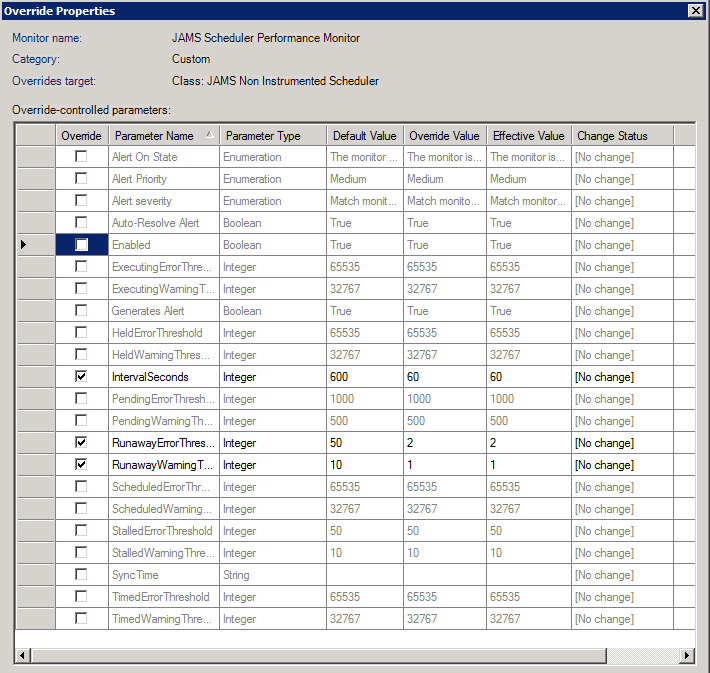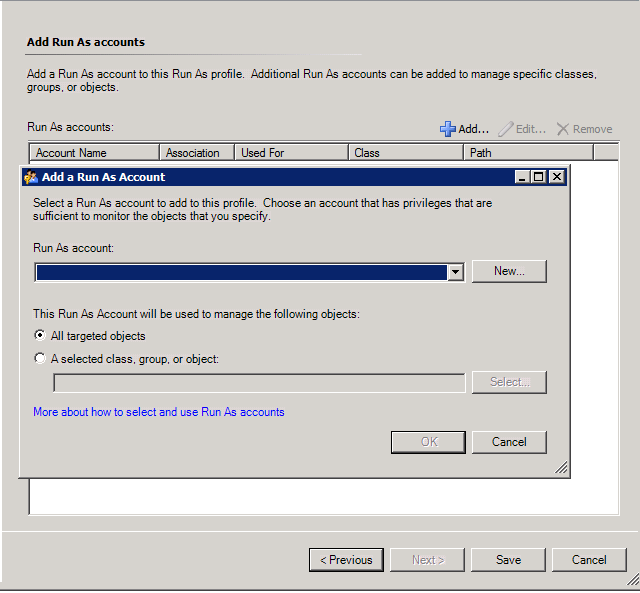The JAMS Management Pack provides monitoring of JAMS components and services using Microsoft SCOM 2007R2, 2012 and 2012 R2. The monitoring includes availability, health and performance data collection. In addition to these monitoring capabilities, the Management Pack supports Agent tasks and Dashboard views. The 6.2 version of the Management Pack supports monitoring of JAMS on the Windows operating system only. Support for other operating systems may be added at a later date.
Preparing to Import the Management Pack
To ensure that target JAMS computers are managed by the SCOM Agents (preferably using LocalSystem account), the account used by the SCOM Agent must have adequate permissions to access JAMS program directory, the system registry and access JAMS data via its PowerShell provider.
 |
Note: You can use local accounts on managed computers and/or dedicated domain accounts to execute Management Pack rules and monitors; however, you will also need to configure the JAMS ‘Run As’ profile account using SCOM’s operations console as outlined below. |
It is recommended the target computer with the JAMS Scheduler role have the PowerShell feature enabled or installed. Please refer to the JAMS Installation Guide for additional information. It is also recommended that you install the JAMS Instrumentation Integration for each managed JAMS Scheduler machine in order to reduce overhead and improve functionality of the Management Pack.
Importing the Management Pack
The Management Pack consists of a single file: MVP.JAMS.mp
For general import instructions go to the article: http://technet.microsoft.com/en-us/library/cc974494.aspx
- Log on to the computer using an account that is a member of the Operations Manager Administrators role within the Operations Manager management group.
- From the Operations console, click Administration. When you run the Operations console on a computer that is not a management server, the ‘Connect To Server’ dialog box appears. In the Server name text box type the name of the management server that you want the Operations console to connect to.
- Right-click the Management Packs node and then click Import Management Packs.
- The Import Management Packs wizard opens. Click the Add button and then select Add from disk.
- The Select Management Packs to import dialog box appears. Change to the directory that contains the JAMS Management Pack file. Select MVP.JAMS and then click Open.
- On the Select Management Packs page the management pack that you selected for import should be listed. Choose Import.
- The Import Management Packs page appears and displays the import progress. If there is a problem at any stage of the import process select the management pack to view the status details. Click Close.
Discovery
After importing the JAMS Management Pack, SCOM runs a discovery process on all managed Windows computers in order to locate the JAMS installations. By default SCOM discovers all JAMS installations on Windows. No additional configuration should be necessary for most customer environments.
Customizing the Management Pack
The JAMS Management Pack is ‘sealed’, preventing any setting changes in the original Management Pack file. However, you can still perform and save customizations such as overrides for monitors, alert rules and views, and save them to a different management pack.
By default SCOM saves all customizations to the Default Management Pack. As a best practice you should instead create a new management pack for each sealed management pack you want to customize.
For more information about management pack customizations and the Default Management Pack, link to the article: http://go.microsoft.com/fwlink/?LinkId=217006
The (6.2) version of the Management Pack includes the following customizations:
- JAMS Scheduler Performance Monitor. Note that there are 2 monitors targeting the JAMS Scheduler with and without the Instrumentation Integration installed (JAMS Instrumented Scheduler and JAMS Non-Instrumented Scheduler). Both monitors have identical thresholds for the number of currently executed or pending Job with a specific status.
You can disable these monitors and/or provide the overrides for the frequency as well as warning and error thresholds. The screenshot below illustrates the Scheduler Performance Monitor parameters that can be overridden using the SCOM Operations Console.

- There are 2 alert rules that are defined for the Instrumented Scheduler class:
-JAMS Scheduler Execution Warning
-JAMS Scheduler Execution Error
These rules can be enabled or overridden to produce Scheduler alerts based on the level of events logged to MVPSI JAMS/Operational by the JAMS Instrumentation Integrations.
- JAMS Scheduler (performance) collection rules can be disabled or the frequency (IntervalSeconds) can be adjusted.
 |
Note: there are separate set of rules for Instrumented and Non-Instrumented Scheduler classes. |
- New monitors and rules can be easily added using new performance counters and/or ETW events implemented in the JAMS Instrumentation Integrations.
 |
Note: corresponding providers are available only on Scheduler machines that have Instrumentation Integrations installed. These JAMS Scheduler instances are discovered as instances of ‘JAMS Instrumented Scheduler’ class derived from ‘JAMS Scheduler’ class. |
The JAMS Management Pack creates ‘Run As’ profile named ‘Account for JAMS Collection Rules’ as shown on the screenshot below. You can associate one or more SCOM accounts with this profile to define local or domain accounts that should be used by the management pack rules and monitors on each computer. Refer to SCOM documentation for further information on ‘Run As’ configuration.

Removing the Management Pack
For additional information on removing the Management Pack, go to the article: http://technet.microsoft.com/en-us/library/cc974489.aspx